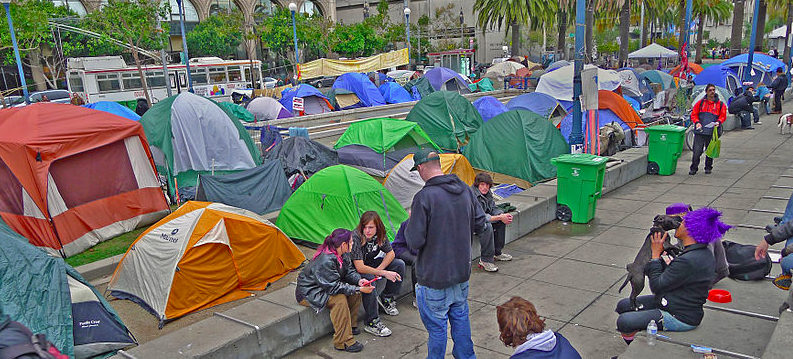Occupy San Francisco took place ten years ago in the Bocce Ball Court at the end of Market Street on the Embarcadero overlooking the Bay Bridge. It was also, conveniently, one block away from the San Francisco branch of Federal Reserve Bank, the perfect symbol of capitalism.
Those wonderful weeks of Occupy, staged throughout the United States, changed the narrative about wealth and the status of workers forever. If nothing else it enshrined the “99 percent” concept to define the difference between workers and the Walmarts and Jeff Bezos and Elon Musks of the world who exist entirely for the amalgamation of wealth, with no desire to think of the many Americans who struggle every day to earn a living, pay for rent and food and transportation and health care—the necessities of a healthy life.

We are the 99 percent. A real class distinction.
Occupy was quite possibly the most unorganized movement that ever existed. It had no leaders or organizational structure. The closest thing to discipline was a fluttering of hands. Floppy-floppy wiggling in upstretched arms for good shit and bam-bam down gestures for a respectful booing. “Mic check, Mic check” became the norm for one to be recognized in a democratic queue to speak.
And anyone could speak. For as long as they wanted. Whether an established leader or someone who wanted to speak for an hour about how baggies of sand from the beach should be the new currency of choice, one bag for lettuce, eight bags to buy a bus, six for….
The media went wild because this was a takeover. Zuccoti Park in Manhattan, Grant Park in Chicago, etc. But there was no structure except the new, wonderfully arbitrary slogans that appeared spontaneously almost every day. The 99 percent.
As head of the Labor Council, I decided to embrace Occupy and this excitement from the onset. There was some grumbling at my attendance at rallies and marches, but other unions started to follow. Some even used their weight to add resources to this gathering. (Unions are the only self-sustaining workers’ rights organizations in America. Workers elect to join their trade union and expect their leaders to fight for them.)
Amid the scattering of constituencies and squatters and activists that “occupied” the bocce ball court, some of our unions established visible support and a presence. The nurses set up and staffed a 24-hour tent for healthcare needs. The teamsters provided a big flatbed truck and sound system for rallies, porta potties, cases of water and other emergency supplies. I made sure that the Labor Council updated our affiliates and allies daily of the rallies and marches and sundry events. I also cranked up our media team to promote labor’s support for this phenomenon. It was a fun part of my crazy job.
None of us will forget the marches and sit downs and the constant presence on the Embarcadero.
One historic illustration of the excitement is that the Mayor’s Office called me and asked to “help.”
“Tim, can you come to City Hall?”
“I will only come if I can bring an Occupy organizer, OK?”
The Mayor’s Office offered the Labor Council an abandoned school and playground in the Mission with working bathrooms. Wow! We would only have to pay $1,000 a month for liability insurance. Sounded good to me. But that wasn’t what Occupy was about. Occupy was not going to get coopted at any price.
Eventually the momentum slowed. There was no plan for any ongoing structure. The Bernie Sanders thing and the Black Lives Matter and the Social Democrats would later use the issues spawned by Occupy to make more ongoing “structures,” but the moments and weeks of Occupy changed and radicalized many new organizers who were looking for a spark to stay engaged.
The Bocce Ball Court stayed crowded and vital, but the health conditions began to erode. Non-political homeless folks who were part of our movement by finding a safe home still had to pee, and Occupy’s base began to outweigh the porta potties. Even the health and safety volunteers had their hands tied. City Hall was looking for a way out.
But they played into our hands when my reconnaissance informed me that the police were told to dismantle the encampment on a date certain. I was encouraged to negotiate, a position that I had no authority to do because nobody would ever agree to disband. On the night the order was given to descend, I heard that 200 cops were being trained on Treasure Island. So I organized half of the Board of Supervisors and many labor leaders to come to Occupy to resist.
I was told they were all in uniform and with billy clubs and shields like they were going to defend the Edmond Pettis fucking Bridge.
I engaged all media, who gladly flocked down for this “standoff.” Occupier organizers had a ball and drove us crazy by moving us from place to place on the Bocce Ball Court for the best position “to fight the police.”
Finally, looking towards the Bay Bridge, I noticed the lights got brighter and, sure enough, brightly lit black trucks and wagons were marching towards San Francisco.
It was midnight and all the TV cameras were lit up as I arranged for us to sit at the (finally decided) entrance to the park.
We all chanted “99, 99! Occupy, Occupy!”
Eventually my phone rang, and I was told that the police had turned back. We stood up in celebration. Folks gave media quotes. We declared Victory.
Zucotti Park and San Francisco were the longest and most publicized Occupy demonstrations. It was pretty inspiring. Game changing.
Two days later Park and Rec and Public Works cleared the last of the homeless stranglers, and the older Italian guys could resume rolling their bocce balls.
Tim Paulson was executive director of the San Francisco Labor Council.



